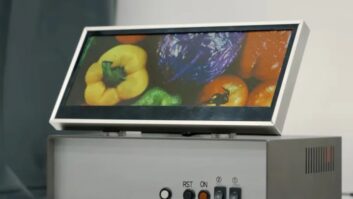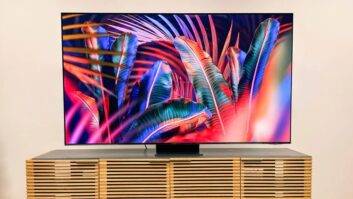NEW YORK – OLED televisions have been pitched by manufacturers for the past several years as the Holy Grail of display technologies.
Myriad benefits are assured, including some of the deepest black levels produced by a consumer display, paper-thin screens, bright self-emissive panels yielding highly saturated colors, and very wide viewing angles.
The first large-format (55-inch) OLED TVs made their debut from LG and Samsung last year, delivering the promised image and form-factor benefits, coupled with the industry’s first curved screens – a design element that both puzzled and fascinated tech enthusiasts as it quickly migrated to LED LCD sets under several brands.
Both the Samsung and LG systems immediately caught the fancy of most reviewers and technology enthusiasts, alike, but high introductory prices ($8,999 for the Samsung and $14,999, slashed to $9,999, for LG) kept demand at expectedly low levels.
And that’s, perhaps, a good thing, since first-year production volumes delivered yields of 30 percent or lower on average, according to some estimates. LG claimed its technology approach produces higher yields – a point perhaps validated by the company’s aggressive second-generation line expansion plans, while Samsung has been silent.
LG’s approach to OLED, called WOLED technology on Oxide backplanes, uses a grid made up of white OLEDs, over which are placed a series of color filters to produce four different subpixels: red, green, blue and white. The approach is said to produce a panel that can produce much higher brightness, and avoids a problem of premature aging of blue pixels seen in other OLED approaches.
In contrast, Samsung’s OLED technology, called RGB technology on LTPS backplanes, incorporates discrete red, green and blue subpixels into its display, in a similar fashion to a plasma or LED LCD. Whether or not Samsung’s sets will exhibit the blue pixel aging problem cited by some developers remains to be seen, although the company disputes the likelihood of any such problem under normal consumer usage patterns.
But, the high cost, low-yield situation continues to be a sticking point.
“To stay competitive in pricing with high-end 4K sets, the OLED manufacturing yields need to increase to more than 50 percent, and realistically achieve 70-80 percent within a few years. So far, the production technology (backplanes, deposition, encapsulation, etc.) have been difficult to perfect in large sizes,” said Paul Gagnon, Display- Search global TV research director.
To achieve large production volume for larger TV sizes, 55-inch-plus, manufacturers need to invest in a large fab plants – G8 or larger, ideally. “Those are not small investments to dedicate to a single product, so to put the money forward, the firms need confidence they increase the yield rates to acceptable levels for cost competitiveness,” Gagnon added.
Recent reports out of Asia said Sony had decided to stop its development of large-screen OLED TVs – this followed an announcement last December that it had scrapped plans for a joint venture OLED manufacturing plant with Panasonic.
But the company told TWICE: “Sony continues developing and looking into reliable ways to massproduce OLED displays for consumers while continuing to build experience via providing OLED displays for professional, medical and broadcast use.”
For this year, Sony is focusing on developing 4K Ultra HD LED LCD TVs that integrate a suite of new picture enhancement approaches, including QD Vision’s Color IQ quantum dot technology that is said to greatly expand the reproducible color spectrum to OLED-like levels.
Similarly, a Nikkei report said Samsung canceled plans for a new large-panel OLED factory scheduled for this year, although the company is reportedly still slated to invest between $3 billion to $5 billion this year in small- and large-screen OLED development.
Dave Das, Samsung home entertainment marketing VP, told TWICE: “While we can’t comment specifically on long-range forecasts, Samsung will continue our investments and R&D in OLED TVs, according to market demands.”
He added that Samsung is “committed to providing consumers with the best possible viewing experience, accomplishing this through our curved UHD, OLED, LED and plasma TVs. Our broad range of TVs fulfill the specific needs of consumers, offering them multiple choices that best fit their lifestyle.”
Meanwhile, Sharp and its investor AU Optronics from Taiwan are reportedly spending up to $830 million this year on OLED development, and Panasonic has revealed development of an inkjet technology for the production of large-format OLED panels, with plans to begin production in 2016.
DisplaySearch’s Gagnon said North American OLED TV shipments have been small so far, hitting just 1,254 units through the first quarter of 2014, with the large majority of those coming from LG.
“For this year, we are forecasting a small amount, only about 16,000 units in North America and around 100,000 worldwide. There is still a lot of proving to do to demonstrate manufacturing scale and cost reduction, which would allow for better long-term growth, so our conservative outlook is for about 3 million units by 2017.”
Where Samsung’s continued OLED TV marketing plans have been quiet, LG’s plans have been loudly trumpeted, as the manufacturer is in the stages of rolling out a second generation lineup with screen sizes of 77, 65 and 55 inches.
LG said it “continues to improve the quality and range of its OLED models while expanding its global production capabilities.”
Going forward, the company’s strategy is “to bring the benefits of OLED TV technology to as many consumers as possible,” by offering OLED sets in both FullHD and Ultra HD resolution levels.
Currently available in OLED from LG is the Gallery Series wall-mountable FullHD 55-inch 55EA8800 ($8,499), featuring a high-end picture frame cosmetic and an advanced 100-watt speaker system.
The company also added a second-generation 55-inch FullHD curved-screen (tabletop or wallhangable) model 55EA9800 at a $7,999 retail.
LG’s 2014 OLED sets will incorporate the company’s eGallery feature with more than 150 works of mood-enhancing content, including masterwork paintings and landscape images, accompanied musical soundtracks.
The models also include the firm’s WebOS Smart + TV platform offering simplified content searching, selection, connecting with other devices and setup process.
Later in the second half, LG plans to add its 65-inch FullHD and 77-inch 77EC9800 curvedscreen Ultra HD models.













